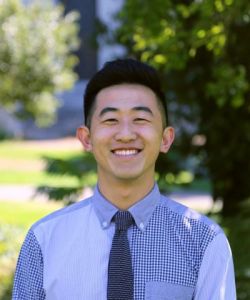
What sparked your interest in science?
My dad is an immunologist, so I was fortunate enough to be exposed to science at a young age. In high school, I participated in Science Olympiad events, and also worked in a cancer research lab, where I learned basic molecular biology techniques. Both labwork and interactions with my colleagues helped me appreciate the beauty of scientific research.
What attracted you to UC Berkeley?
Berkeley's MCB department is the most welcoming and supportive community of any of the schools I applied to for graduate school. Not only are students incredibly intelligent and sociable, but faculty members are also engaged and available. It is unusual to find a place with such high-caliber researchers who are also so kind. The location is also ideal, as the Bay Area is a place with great weather and many opportunities for exploration, both in and out of science.
What are you currently working on in the lab?
I work with Prof. Nipam Patel, who studies arthropod development and evolution. My project involves identifying cis-regulatory elements that have contributed to body plan diversity across crustaceans. In particular, I am focused on enhancers regulating the Homeobox (Hox) family of genes, which is conserved throughout animals. I also hope to work with Prof. Hernan Garcia to do some more biophysical characterization of these enhancers once they have been identified. Prof. Garcia uses quantitative imaging and modeling approaches to study enhancers in Drosophila. Using the tools and techniques his lab has developed and optimized, we might more mechanistically probe enhancer evolution in crustaceans.
Describe your ultimate dream/goal for your future.
It's still too early for me to decide whether I want to continue the academic path or take the industry path. If I continue in academia, I am interested in continuing to expand the repertoire of model systems available to molecular biologists through embryology, CRISPR genome editing, and genomics. However, I know that Berkeley provides a wealth of resources and opportunities for students looking to enter the industry. From site visits to networking sessions to internships, there are a wide range of connections that students can make with the industry.
When I'm not in the lab, I can be found...
Exercising at the RSF or running around Berkeley; taking advantage of the social, cultural, gastronomical, and natural diversity of the Bay Area; designing for the Berkeley Science Review; cooking, baking, and drinking with classmates.
If you could go back in time and give yourself a piece of advice during your first year in graduate school, what would you say?
Take advantage of the free time you have to really socialize with your classmates. Not only can they provide experimental expertise in unfamiliar fields, but they are also an incredible source of emotional and psychological support. Graduate school is challenging, and events that happen outside of the lab can make it even harder. Having a strong social safety net can make your life much happier and more secure.